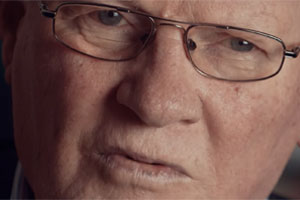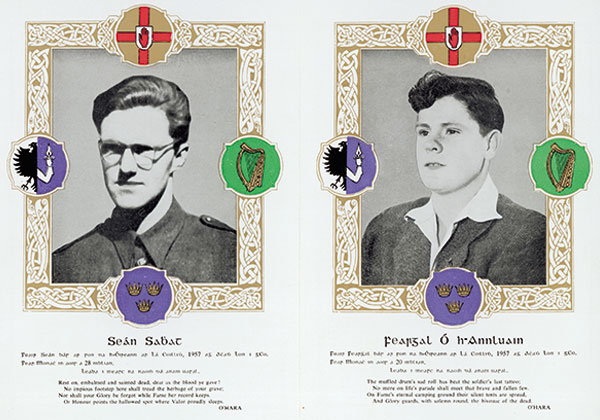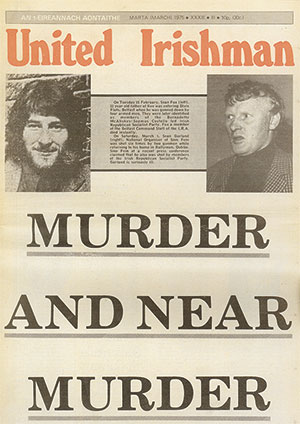The man with the hat: the revolutionary life and times of Seán Garland
Published in Issue 6 (November/December 2018), Reviews, Troubles, Volume 26A Gansee production, directed by Kevin Brannigan and Graham Seely
By Brian Hanley

Above: Seán Garland—access to Garland himself is this documentary’s strength but also its greatest weakness.
By any standards Seán Garland has led an interesting life. Raised in the tenements of north inner city Dublin, by his early twenties he was already an iconic figure among Irish republicans. Joining the IRA in 1953, he shortly afterwards enlisted in the Royal Irish Fusiliers, based in Armagh, with the aim of preparing the ground for a raid on their barracks. The IRA’s successful removal of over 100 weapons from the base brought both international headlines and new recruits. Garland remained behind, only deserting when his regiment was due to depart for Kenya. On 1 January 1957 he was badly wounded in the attack on Brookeborough barracks in which his comrades Seán South and Fergal O’Hanlon were killed. Garland was jailed in Dublin during 1957 and later in Belfast, where he spent the later stages of the Border Campaign. He became a leading figure in the republican leadership during the 1960s, as it sought to draw lessons from the campaign.
While many commentators have lazily described the politics of the left within the IRA in that period as ‘Marxist’, Garland was one of the few to whom the label could genuinely be applied. During the 1970s he was central in the transition of the Official republicans into the Workers’ Party (though by then he would have been better known among activists than among the general public), and he remained loyal to the Workers’ Party when a majority of its public representatives departed in 1992 to form Democratic Left. Garland returned dramatically to public attention in 2005, when he was subject to unsuccessful extradition proceedings after being accused of involvement in a plot by North Korea to counterfeit American dollars. As the anniversaries of the outbreak of the conflict in Northern Ireland approach, it is important that all the contending narratives, including those of the Official republicans, are explored. Through the use of evocative footage, recent interviews with Garland himself and some material recorded during the 1980s, what became the ‘Official’ view of the evolution of their movement is explained.
This documentary’s strength—access to Garland himself—is also its greatest weakness. It does not appear that Garland has reflected critically on any aspect of his political life after the Border Campaign (or perhaps he does not want to do so publicly). Therefore anyone with a basic understanding of the history of the Workers’ Party will have heard much of this before. Those looking for the complexities and nuances will have to go elsewhere. This is evident in the discussion of the civil rights movement, for instance, when what republicans were arguing for and doing on the ground bears little relation to the Workers’ Party’s retelling of that story. Indeed, at Easter 1969 in Belfast, Garland himself reiterated that their ‘most important task [was] the ending of British domination of this country [and] to force the withdrawal, by any and every means in our power, of British troops’. (Incidentally, on that occasion the Proclamation was read by a young Gerry Adams.) It is clear that Garland remains very bitter about the three major splits (1969–70, 1974–5 and 1992) that affected his movement.
This bitterness is completely understandable; friends and comrades were killed and Garland himself badly wounded, but the lack of any contending voices weakens rather than strengthens the narrative. For the Workers’ Party, hatred of the Provisonals became almost their raison d’être, ultimately leading the party publicly to back the RUC and privately to cooperate with British security services. By the 1980s their public pronouncements on paramilitarism were often delivered in a hysterical ‘holier-than-thou’ tone, with no acknowledgement at all of many of the events catalogued in this documentary. Garland’s account of the split with Seamus Costello that led to the formation of the Irish Republican Socialist Party is particularly disingenuous. Costello and Garland were allies in the key debates around the ‘National Question’ within the Official movement during 1972. A policy document on the issue, co-authored by both men, was carried at the Official IRA’s convention. It would have been interesting to hear his thoughts on this.

Above: Contemporary memorial leaflet for Seán South and Fergal O’Hanlon, killed in the attack on Brookeborough RUC barracks on 1 January 1957 in which Seán Garland was seriously wounded. (Des Long)

Above: The United Irishman of March 1975 reports on the ongoing feud with the IRSP/INLA, in which Garland was seriously wounded.
The Official IRA ceasefire of May 1972 was conditional, and as late as 1976 the organisation was claiming attacks on British soldiers. While Garland now claims that he sees the disastrous Aldershot bombing as ‘terrorist’, it is unclear whether this is because of its tragic consequences or the operation itself; in fact, the Official IRA carried out similar car-bomb attacks on British bases after its 1972 ceasefire. Some may get vicarious thrills from the nod-and-wink discussion about bank robberies, but in its most electorally successful period the Workers’ Party denounced such activities and called for support for the state in combating them. Indeed, the existence of any kind of Official IRA was denied, not only to the media but also to Workers’ Party activists, supporters and voters. The 1992 split therefore cannot simply be explained by ‘opportunists’ who joined the party in order to advance their careers and then ‘betrayed’ a ‘sound’ membership. That some of those who supported Democratic Left had joined the movement when it did not have a single elected representative in Dublin, let alone a TD, and that others had been on the front line of party activities in Belfast and elsewhere make such designations problematic. The majority of Workers’ Party members in the 1980s (particularly in the south) were not privy to information about a whole variety of activities, from building-site fraud to sending cadres to North Korea for arms training. While Garland left behind much of the politics of the movement he joined in 1953, he never seems to have abandoned conspiracy. This fascinating documentary should help provoke debate on whether such conspiracies have anything to offer progressive politics in the 21st century.
Brian Hanley is a research fellow at the University of Edinburgh.
















